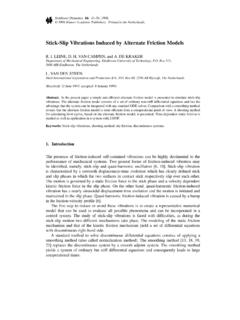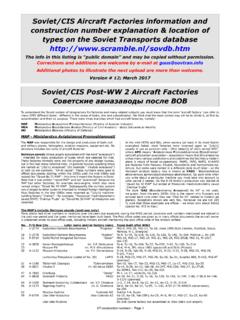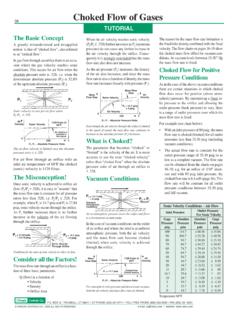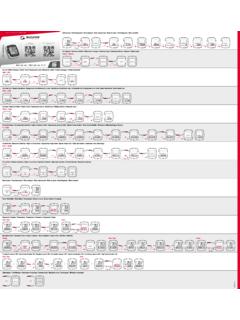Transcription of Fracture Mechanics - Materials Technology
1 Fracture MechanicsLecture notes - course 4A780 Concept SchreursEindhoven University of TechnologyDepartment of Mechanical EngineeringMaterials TechnologySeptember 6, 2012 Contents1 Introduction12 Fracture Fracture mechanisms .. Shearing .. Cleavage .. Fatigue .. Crazing .. De-adhesion .. Ductile - brittle behavior .. Charpy v-notch test .. Theoretical strength .. Discrepancy with experimental observations .. Griffith s experiments .. Crack loading modes .. 183 Experimental Surface cracks .. Electrical resistance .. X-ray .. Ultrasound .. Acoustic emission .. Adhesion tests ..214 Fracture Energy balance .. Griffith s energy balance .. Griffith stress .. Discrepancy with experimental observations .. Compliance change .. Fixed grips .. Constant load .. Experiment .. Examples .. 29 III5 Stress Deformation and strain .. Stress .. Linear elastic material behavior.
2 Equilibrium equations .. Plane stress .. Plane strain .. Displacement method .. Stress function method .. Circular hole in infinite plate .. Elliptical hole .. 446 Crack tip Complex plane .. Complex variables .. Complex functions .. Laplace operator .. Bi-harmonic equation .. Solution of bi-harmonic equation .. Stresses .. Displacement .. Choice of complex functions .. Displacement components .. Mode I .. Displacement .. Stress components .. Stress intensity factor .. Crack tip solution .. Mode II .. Displacement .. Stress intensity factor .. Crack tip solution .. Mode III .. Laplace equation .. Displacement .. Stress components .. Stress intensity factor .. Crack tip solution .. Crack tip stress (mode I, II, III) .. SIF for specified cases .. crack growth criteria .. RelationG K.. The critical SIF value.
3 62 III7 Multi-mode crack Stress component transformation .. Multi-mode load .. Crack growth direction .. Maximum tangential stress criterion .. Strain energy density (SED) criterion .. 728 Dynamic Fracture Crack growth rate .. Elastic wave speeds .. Crack tip stress .. Crack branching .. Fast Fracture and crack arrest .. Experiments ..829 Plastic crack tip Von Mises and Tresca yield criteria .. Principal stresses at the crack tip .. Von Mises plastic zone .. Tresca plastic zone .. Influence of the plate thickness .. Shear planes .. Plastic zone in the crack plane .. Irwin plastic zone correction .. Dugdale-Barenblatt plastic zone correction .. Plastic constraint factor .. Plastic zones in the crack plane .. Small Scale Yielding .. 9210 Nonlinear Fracture Crack-tip opening displacement .. CTOD by Irwin .. CTOD by Dugdale .. CTOD crack growth criterion.
4 Integral along closed curve .. Path independence .. RelationJ K.. HRR crack tip stresses and strains .. Ramberg-Osgood material law .. HRR-solution .. crack growth criterion .. 10111 Numerical Fracture Quadratic elements .. Crack tip mesh .. Special elements .. Quarter point elements .. One-dimensional case .. Virtual crack extension method (VCEM) .. Stress intensity factor .. J-integral .. Domain integration .. De LorenziJ-integral : VCE technique .. Crack growth simulation .. Node release .. Moving Crack Tip Mesh .. Element splitting .. Smeared crack approach .. 11412 Crack surface .. Experiments .. Fatigue load .. Fatigue limit .. (S-N)-curve .. Influence of average stress .. (P-S-N)-curve .. High/low cycle fatigue .. Basquin relation .. Manson-Coffin relation .. Total strain-life curve .. Influence factors .. Load spectrum .. Stress concentrations .. Stress gradients.
5 Material properties .. Surface quality .. Environment .. Crack growth .. Crack growth models .. Paris law .. Fatigue life .. Other crack grow laws .. Crack growth at low cycle fatigue .. Load spectrum .. Random load .. Tensile overload .. Design against fatigue .. 13713 Engineering plastics (polymers) Mechanical properties .. Damage .. Properties of engineering plastics .. Fatigue .. 141A Laplace equationa1B Derivatives of Airy functiona3 Chapter 1 IntroductionImportant aspects of technological and biological structures are stiffness and strength. Re-quirements on stiffness, being the resistance against reversible deformation, may vary over awide range. Strength, the resistance against irreversibledeformation, is always required tobe high, because this deformation may lead to loss of functionality and even global :Stiffness and mechanicsWhen material properties and associated mechanical variables can be assumed to be con-tinuous functions of spatial coordinates, analysis of mechanical behavior can be done withContinuum Mechanics .
6 This may also apply to permanent deformation, although this is as-sociated with structural changes, phase transformation, dislocation movement, molecularslip and breaking of atomic bonds. The only requirement is that the material behavior isstudied on a scale, large enough to allow small scale discontinuities to be averaged a three-dimensional continuum is subjected to external loads it will deform. Thestrain components, which are derived from the displacementsui(i= 1,2,3) by differentiation ( ),j with respect to spatial coordinatesxj(j= 1,2,3), are related by the stress components ij(i,j= 1,2,3) must satisfy the equilibrium equations partialdifferential equations and boundary most cases the equilibrium equations are impossible to solve without taking intoaccount the material behavior, which is characterized by a material model, relating stresscomponents ijto strain components kl(k,l= 1,2,3).~xA0AV~x0V0~uO~e1~e2~e3 Fig. :Deformation of a volume / areaV0,V/A0,A- base vectors{~e1,~e2,~e3}- position vector~x0,~x- displacement vector~u- strains kl=12(uk,l+ul,k)- compatibility relations- equilibrium equations ij,j+ qi= 0; ij= ji- density - load/massqi- boundary conditionspi= ijnj- material model ij=Nij( kl)Material behaviorTo investigate, model and characterize the material behaviour, it is necessary to do experi-ments.
7 The most simple experiment is the tensile/compression loading of a tensile and stress-time curves reveal much information about the material behavior,which can be concluded to be elastic : reversible, time-independent; visco-elastic : reversible,time-dependent; elasto-plastic : irreversible, time-independent; visco-plastic : irreversible,time-dependent; damage : irreversible, decreasing :Tensile t2 t1t2t1tt2t t1t2t1tt t1t2t1t2 e pt2tt t1t2t1 Fig. :Stress excitation and strain response as function of anticlockwise: elastic, elasto-plastic, visco-elastic, curves may show linear, nonlinear, hardening and softening behavior. Fig. :Stress-strain curves for hardening (left) and sofening (right) material material damage like micro-cracks and voids grow in size and become localized, theaveraging procedure can no longer be applied and discontinuities must be taken into localization results in a macroscopic crack, which maygrow very fast, resulting in early approaches have striven to predict fractureby analyzing the behavior ofatomic bonds, Griffith has shown in 1921 that attention shouldbe given to the behavior ofan existing :Tensile test with axial elongation and mechanicsIn Fracture Mechanics attention is basically focused on a single crack.
8 Theoretical conceptsand experimental techniques have been and are being developed, which allow answers toquestions like: Will a crack grow under the given load ? When a crack grows, what is its speed and direction ? Will crack growth stop ? What is the residual strength of a construction (part) as a function of the (initial) cracklength and the load ? What is the proper inspection frequency ? When must the part be repaired or replaced ?Several fields of science are involved in answering these questions : material science andchemistry, theoretical and numerical mathematics, experimental and theoretical a result, the field of Fracture Mechanics can be subdividedin several specializations, eachwith its own concepts, theory and :Crack in a bicycle crank.(Source: internet)Experimental Fracture mechanicsDetection of cracks is done by experimental techniques, ranging from simple and cheap tosophisticated and Fracture Mechanics (EFM) is about the use anddevelopment of hardware and procedures, not only for crack detection, but, moreover, for theaccurate determination of its geometry and loading :Experimental tensile equipment.
9 (Source: Internet)Linear elastic Fracture mechanicsA large field of Fracture Mechanics uses concepts and theories in which linear elastic materialbehavior is an essential assumption. This is the case forLinear Elastic Fracture Mechanics (LEFM).Prediction of crack growth can be based on an energy criterionstates that crack growth will occur, when there is enough energy available to generate newcrack surface. Theenergy release rateis an essential quantity in energy balance criteria. The6resulting crack growth criterion is referred to as beingglobal, because a rather large volumeof material is crack growth criterion can also be based on the stress state at the crack tip. Thisstress field can be determined analytically. It is characterized by thestress intensity resulting crack growth criterion is referred to aslocal, because attention is focused at asmall material volume at the crack of linear elastic material behavior leads to infinite stresses at the crack reality this is obviously not possible: plastic deformation will occur in the crack tip yield criteria (Von Mises, Tresca), the crack tip plastic zone can be determined.
10 Whenthis zone is small enough (Small Scale Yielding, SSY), LEFM concepts can be :Plastic strain zone at the crack Fracture mechanicsIt is important to predict whether a crack will grow or not. Itis also essential to predict thespeed and direction of its growth. Theories and methods for this purpose are the subject ofDynamic Fracture Mechanics (DFM).Fig. :Impact of a bullet in a plate [39].7 Nonlinear Fracture mechanicsWhen the plastic crack tip zone is too large, the stress and strain fields from LEFM are notvalid any more. This is also the case when the material behavior is nonlinear elastic ( inpolymers and composites). Crack growth criteria can no longer be formulated with the stressintensity Fracture Mechanics (EPFM) orNon-Linear Fracture Mechanics (NLFM)criteria are derived, based on theCrack Tip Opening Displacement. Its calculation is possibleusing models of Irwin or Dugdale-Barenblatt for the crack tip crack growth parameter, much used in NLFM, is theJ-integral, which charac-terizes the stress/deformation state in the crack tip techniquesAnalytical calculation of relevant quantities is only possible for some very simple cases.







